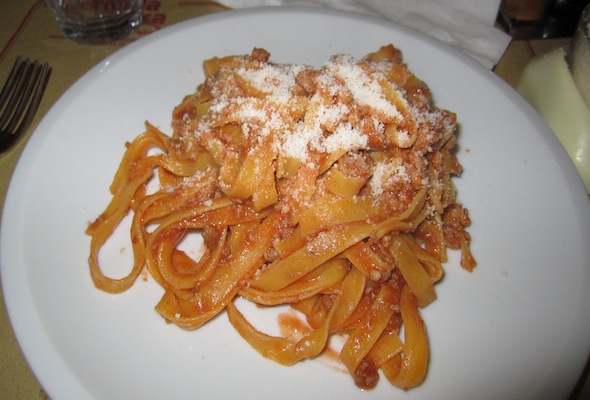Memories in a meat sauce
My family tries to have dinner together every night. We have a rotating collection of dinner favorites, but there is one dish that is our fail-safe; spaghetti bolognese. It never disappoints. It is comforting, filling and easy to prepare. Every member of my family knows how to make it, and we can all tell when it’s good. The secret is a lengthy cooking time, a cook who knows when to slow down on the tomato paste, and a sprinkling of nutmeg at the end.
Spaghetti bolognese holds meaning because of the recipe, which came from my grandmother, handwritten on a recipe card in her almost indecipherable, tightly coiled scrawl. When my family moved to Australia from South Africa 15 years ago, we left my grandparents in Johannesburg. My grandmother was a great cook. She made homey and comforting meals, and every year, when we headed back to South Africa for a visit, we knew that her freezer would be filled with meals she had precooked, ready and waiting for us. Spaghetti bolognese was always one of them.

Tagliatelle al ragu in Bologna. Photo: Sophia Morris.
I don’t remember this, but my brother says that when we moved to Sydney, my parents tried to recreate the bolognese. It wasn’t the same, and on the next visit they requested the recipe card from my grandmother. Since then, we have eaten spaghetti bolognese at least once every two weeks. I don’t know where my grandmother got the recipe, or what prompted her to write it down. She was a meticulous preserver of recipes, keeping a box of recipe cards precisely indexed in a red box. The box is in Sydney now, along with many of her things after she died in 2012.
My grandmother had visited Italy, but she wasn’t aiming for Italian authenticity with her bolognese. Still, I had no idea just how inauthentic her bolognese was until I moved to Italy in 2011. I had chosen to do my study abroad year in the northern city of Bologna. There was only one thing I knew about the city, Bologna was the home of bolognese. It’s right there in the name. For me, this was a good sign.
La dotta, la grassa e la rossa. This is how Italians often describe Bologna. La dotta: the learned thanks to its university, the oldest in Europe, la grassa: the fat, thanks to the rich and delicious food that the city is famous for, and la rossa: the red, because of the terracotta roofs of the city’s buildings, and the city’s strong ties to the Communist Party.
Bologna is a city built for wandering. It is full of small, winding roads edged with porticos, piazzas, secret canals, and hundreds of restaurants. Arriving in the city, I felt overwhelmed and very far from home. My grasp of the Italian language seemed to disappear whenever I was confronted with an actual Italian. There was one thing that I had confidence in, my ability to order from a menu. Perusing one for the first time, I looked for spaghetti bolognese, knowing that I had to try it.
I would never find spaghetti bolognese in Bologna. It doesn’t exist there. In Bologna, bolognese is ragu, and it is always served with tagliatelle, a thicker, flatter version of spaghetti. I don’t remember where I ordered my first tagliatelle al ragu. But I do remember the tastes and smells of the many ragus that I consumed throughout that year. They have all blended into glorious, meaty memories. The sauce, cooked for hours on end, is a simple blend of pork and veal, with tomatoes, red wine, and seasoning. The pasta and sauce are combined before serving, with grated parmigiano completing the dish. This was not my grandma’s bolognese. She would never have used pork, and she added mushrooms and carrots, sacrilege.
I declared to my friends that I would use my time in Bologna wisely. I would find the best ragu in the city. I never completed my mission, deciding pretty early on that ordering the same thing all the time was restricting my culinary exploration — but through my aborted ragu tour of the city, I got to know it in a deeper way. I mingled with the locals at a hole-in-the-wall my friends and I called nonna pasta, because of the 80-year-old women hand-making pasta in the small kitchen. I shared tables with students at Osteria dell’Orsa, a rowdy restaurant with the atmosphere of a tavern, known for its huge portions and low prices. The ragu was great, though maybe a little salty. One bowl was enough food to last you the day.
Having the comfort of bolognese helped me adjust to life in Australia. In Bologna, I had ragu. It didn’t matter that almost every time I tried to speak Italian, people replied back in English. When I ordered tagliatelle al ragu, I was a local.

Your Comments